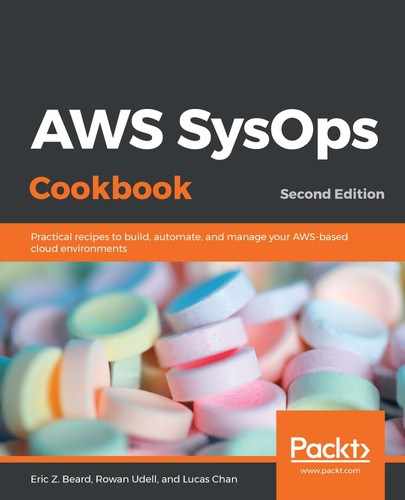In this example, we're actually going to create two S3 buckets for our site (http://www.example.org/). They correspond to www.example.org and example.org hostnames:
- We're going to put all our content in our example.org bucket and tell S3 that requests to www.example.org should be redirected to the other bucket. Here's what the relevant parts of CloudFormation would look like for creating these buckets (note that we'll be expanding on this example as we proceed through this recipe). Create a new CloudFormation template file called 03-01-Website.yaml and enter the following code:
Resources:
ApexBucket:
Type: AWS::S3::Bucket
Properties:
BucketName: !Ref DomainName
WWWBucket:
Type: AWS::S3::Bucket
Properties:
BucketName: !Sub
- www.${Domain}
- Domain: !Ref DomainName
This might be a good time to remind you that S3 bucket names are globally unique. You'll need to replace example.org with a domain that you own.
- We won't be hardcoding our domain name into the bucket names. Instead, we're going to supply our domain as a parameter to the CloudFormation template in order to maximize its reusability, and then reference it via !Ref DomainName. To keep this recipe as simple as possible, we're going to set up a single-page website. In the real world, your website will, of course, consist of multiple files, but the process you need to follow is exactly the same.
- Now, we need to configure the index document:
- The index document is the file that S3 will serve by default when someone types your domain name into the address bar in their browser. This precludes the user from having to type the full path to a file, that is, example.org/index.html.
- Typically, your index document will be called index.html. We'll provide a code snippet for this file toward the end of this chapter.
- Next, we need to configure the error document:
- The error document is the file S3 will serve if something goes wrong (missing files, forbidden access, bad requests, and so on). To keep things consistent, we're going to call ours error.html. Again, we'll provide a code snippet for this later in this chapter.
- Now, we need to enable website hosting on our bucket:
- As we mentioned previously, we're going to need to tell S3 that it should serve static website content from our example.org bucket. Often, users will perform this configuration through the S3 web console. We're going to do it in CloudFormation, however. The CLI also offers a nice one-liner for doing this. You're not going to need to run this command; we're just adding it here for reference:
aws s3 website s3://example.org/
--index-document index.html --error-document error.html
- Next, we will set up a redirection from the www hostname:
- When performing this task manually, you have little option but to fire up the web console and configure the www.example.org bucket to redirect to the example.org bucket. There's no handy one-line CLI command for this one. Fortunately, it's easy in CloudFormation, as you'll soon see in the upcoming CloudFormation snippet.
- Let's configure some permissions:
- The last bucket setup task is to configure permissions. By default, S3 buckets are private, and only the bucket owner can see its contents. This is not much use to us in this scenario because we need everyone to be able to see our bucket's contents. This is a public website, after all.
- If we were configuring our bucket manually, we would apply a bucket policy, which looks something like this:
{
"Version":"2012-10-17",
"Statement": [{
"Sid": "Allow Public Access to everything in our bucket",
"Effect": "Allow",
"Principal": "*",
"Action": "s3:GetObject",
"Resource": "arn:aws:s3:::example.org/*"
}
]
}
- Fortunately, in CloudFormation, the task is much simpler. Building on the previous example, the Resources section of our CloudFormation template now looks like this:
Resources:
ApexBucket:
Type: AWS::S3::Bucket
Properties:
BucketName:
Ref: DomainName
AccessControl: PublicRead
WebsiteConfiguration:
IndexDocument: index.html
ErrorDocument: error.html
WWWBucket:
Type: AWS::S3::Bucket
Properties:
BucketName:
Fn::Join: [ ., [ www, Ref: DomainName ] ]
AccessControl: BucketOwnerFullControl
WebsiteConfiguration:
RedirectAllRequestsTo:
HostName:
Ref: ApexBucket
We still have more changes to make to the file, as described in the following section.
